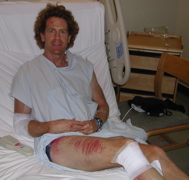
(click to enlarge)

|
|
In the hospital the day after the accident. (click to enlarge) |
I arranged to meet Dave Peckham on the Bill Chipman Trail shortly after 5:00. When we met, Dave had already been riding 45 minutes or so. We took off toward the east with me struggling, as usual, to hold Dave's wheel. At the end of the trail we continued east, eventually getting onto Lenville Road. We wound our way through the hills south of the Troy Highway and had crested our last major hill when I had an idea.
Dave, and just about everyone else who has been riding with me this year, has given me grief about the 23-year-old Bianchi I've been riding. Dave had just invested in component upgrades for his titanium-framed Litespeed. He had also spent many hours and dollars ensuring his fit was as close as possible to perfect. Additionally, he informed me recently, he had bought super-duper new tires that are supposed to have greatly reduced rolling resistance. Dave was the first to admit he didn't know what the manufacturer was comparing when making the claim of a substantial reduction in rolling resistance. Compared to a bagel perhaps?
Now that we had finished our last climb, I wanted to see how my old steel-framed bike with beater tires and antique components would compare to Dave's bike when simply going downhill. A silly test, I know -- there were so many variables we weren't controlling, but I still wanted to do it. We started slowly from the top of the hill, matching our initial speeds and holding approximately the same body positions. No pedaling. We were going to coast for this test.
Down the hill we went. It wasn't too long before Dave started pulling away from me. Not anything dramatic, mind you, but he was clearly ahead. Our speeds crept up there. Neither one of has a cycling computer on his bike, but I'm guessing we were close to 30 mph when I decided the test was over. Dave could be happy that his money was buying him added speed, and I could be happy that my trusty old bike wasn't being left completely in the dust.
With the test over, I had to shift into my highest gear to see if I could pedal fast enough to provide some additional propulsion -- we may have already been going too fast for that. When I moved my shifter, the chain came off the rear derailleur. I'm really good about picking up my chain, while still on the go, when it drops from the front derailleur. I just shift in the direction opposite to the drop. I had never done this with the rear derailleur (since the rear almost never dropped the chain), but I decided that trying to pick up the chain while on the go was worth a shot. I down-shifted and all hell broke loose. I'm not exactly sure what happened, but I heard some crunching and I believe I saw the chain fly into my spokes. My bike stopped in a hurry but, unfortunately, I didn't. I sailed toward the pavement.
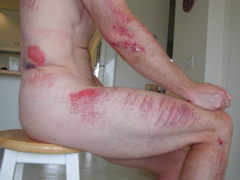
|
|
Hip to knee (with some elbow too) (click to enlarge) |
When I regained consciousness, I think I was on the side of the road. There were other people there besides Dave. I recall a woman named Rose, an older woman who looked very matronly. I was comforted by her presence. I had no idea where I was, how I had gotten there, or why there were so many “floaters” dancing before my eyes. I was not aware of the extent of my injuries. I felt no pain.
An ambulance arrived. It may have been two minutes; it may have been a half hour. I was in a fog. I recall the EMT's putting me on an inflatable back-board contraption to immobilize my neck and back. I also recall that I was trying to do a bit too much myself. They kept telling me not to move, that they would do the moving for me.
In the ambulance my head started to clear a bit. The EMT's asked if I minded if they cut off my biking jersey. “It's pretty much toast already,” they said. Snip, snip, snip.
“Can we cut off your shorts?”
“How do they look?”
“They actually look pretty good.” So, I requested that they keep the scissors away from the shorts. I lifted my hips as best I could and off the shorts came. The next 24 hours I would be living in the burned-out Speedos I use as biking underwear.
After I had been disrobed they started working to clean the road rash that ran, intermittently, from the right side of my forehead to my right ankle. They also asked me a few questions to gauge how extensive my head injury was.
“What's your name?”
“John Schneider”
“What day is it?”
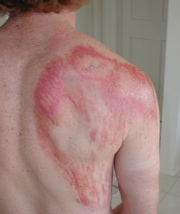
|
|
Right shoulder (click to enlarge) |
This was a tough one. In the summer I pretty much work, and work-out, everyday. The days of the week all blur together even when I haven't been knocked unconscious. But before the day came to me, I recalled that it was “the demonic date”: 06/06/06. So I answered, “Ah! It's the demonic date of 06/06/06.” Being an agnostic, I'm not sure why I was so excited about this, but I was tickled. I also recalled that I had taken Henry to a baseball game and his games are usually on a Tuesday or Thursday. Yes, it was Tuesday and I said as much. Knowing the Doomsday Algorithm, which allows you to calculate any day of the week for any date of the year, it also dawned on me that today, June 6th, was a “doomsday” and this year's doomsdays occur on Tuesdays. However, I decided to keep this to myself. I've tried explaining the Doomsday Algorithm to others several times before and their eyes usually glaze over before I'm done.
They next asked, “Who is the president of the United States?” I wanted to say, “A combination of Karl Rove and Dick Cheney.” However, this being Idaho, I thought it best to keep my smart-ass comments to myself lest I find myself back in a heap alongside the road.
There was one point while I was in the ambulance when I almost started crying. It wasn't because of my injuries but rather when I thought of how this was going to affect Shira. Well, now, that hurt! She didn't need this. She has enough on her plate without having a broken husband to look after. Here's hoping I'll be right as rain in no time!
We got to the emergency room at Gritman Medical Center in Moscow and I was immediately wheeled into ER room number 1. No waiting for me! It's slightly bizarre, but the entire rest of this demonic day I would see nothing but the ceiling tiles of Gritman -- well, that view was interrupted by numerous faces peering over me and making introductions. Paul, Helen, Dr. McKinnon, Adam, etc. Paul was my first nurse in ER. He soaked gauze in lidocaine and draped it up and down my right side. Paul also inserted what was essentially a tap into my left arm into which they injected Tordol (a powerful anti-inflammatory drug), Demerol (a narcotic to kill the pain), and Phenergan (an anti-nausea drug to keep me from barfing since Demerol can do that to people -- were I to vomit I surely would have drowned). This tap was used occasionally over the next 24 hours to inject whatever they wanted injected.
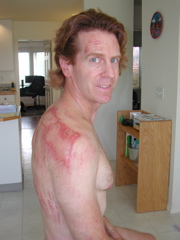
|
|
Forehead and shoulder (click to enlarge) |
After getting the lidocaine-laced bandages put on, Helen and an assistant wheeled me into the X-ray room. They were most concerned about my head and neck. When they moved me, I experienced excruciating pain. Yow! Double yow! The Tordol and Demerol didn't seem to do anything to take the edge off this. To get a good side-shot of my neck, they said they needed to pull down on my arms. I don't know if they knew it at this point, but I had a broken right clavicle (collar bone). Pulling on my arms was hell. I was not the silent stoic.
From X-ray they took me to have a CT scan. Changing from gurney to CT machine back to gurney was another bit of hell. My back was also starting to get incredibly uncomfortable. A pain started to build at just about the center of my spine. Back in ER Room 1, I was told that my head and neck were fine. The neck brace came off. The inflatable backboard had disappeared at some point while I was being moved about. Paul dug at my road rash and, thanks to the lidocaine, I didn't feel any of his digging and cleaning.
Shira arrived. Dave had called her using my cell phone. He also had answered a call from Henry who had finished his baseball game and was wondering where Dad was. Oops! My first words to Shira were, “I'm so sorry, Wife.” She thought my condition couldn't be too bad since my next words were, “Did you bring a camera?” Always best to documents one's stupidity! Unfortunately she didn't think to bring a camera (in any case we later learned cameras aren't allowed in ER). Oh well, there would be time for that.
I complained to Dr. McKinnon that my spine was killing me. She said, “Well, you didn't mention that before.” Silly me! So she decided to have a look at my back. She and a couple nurses tried to roll me on my left side, but I begged them to stop. “STOP!... STOP! I... CAN'T... BREATHE!!!” The pain was truly incredible. I thought I was going to black out. Thankfully they stopped. I said I was sorry to be such a wimp.
They decided to do another round of X-rays and another CT scan. During the previous session there had been at least two people handling me at all times. This time a single guy wheeled me away for the CT scan. He was big. I'm talking football-lineman big. When we got to the CT machine, he transferred me from gurney to exam table with a simple toss. Clearly he had no trouble moving 160 pounds around by himself. But, oh the humanity! I had trouble with him moving 160 pounds around by himself!
Back in Room 1 they finished dressing my wounds. I was declared fit to be moved out of ER and off to a regular room for the night. While there, Dr. McKinnon came in and said, “Well, John, you're not such a wimp.” I cut her off right there.
I said, “I want to be a wimp! Please tell me I'm a wimp!” I don't want to have a broken back. No broken back! Please, please, please.
She said, “You have four broken ribs and a broken clavicle.”
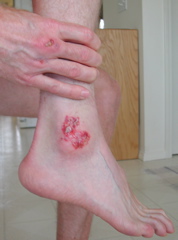
|
|
Right knuckles and right ankle (click to enlarge) |
Yippee! No broken back! No broken neck! My head, unlike my helmet, is in one piece! I am a wimp and the good doctor is just being kind. Fine with me. John the wimp. I love it! Now give me another shot of Demerol and turn out the lights on your way out. Actually, I later learned that four ribs wasn't the full story. I actually have at least seven broken ribs: rib numbers 3, 4, 6, 7, 8, 9, and 10. I'm not sure how rib number 5 escaped, but there you have it.
With the narcotics doing their thing I slept fitfully, my rib cage making sleep very difficult. It felt like I wasn't lying on a bed, but rather on a couple of spikes: one positioned slightly to the right of the center of my spine and another one further to the right of that spot. It wasn't until the next morning that I discovered I was so much more comfortable with the bed propped up. These motorized hospital beds are wonderful. With the push of a button I was in considerably less pain.
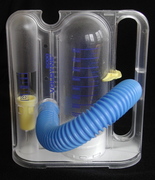
|
|
Incentive inspirometer a.k.a. a torture device (click to enlarge) |
Breathing can be painful with broken ribs, and deep breaths can be excruciating. So, naturally, one takes shallow breaths. Unfortunately, I'm informed by the respiratory therapist, shallow breathing over an extended period is a recipe for pneumonia. My blood oxygen is monitored almost continuously, and they listen to my lungs frequently. I'm told that I will be given an “incentive inspirometer.” Wonderful name! It sounds so upbeat. This device must measure what an inspiration you are, right? In fact, it measures the volume of your “inspired” air, i.e., the volume of your inhalation. Where the “incentive” part of “incentive inspirometer” comes in I have no idea.
When the inspirometer arrives and I have a go at it, I'm not exactly a happy camper. To get close to where I'm supposed to be, 3000 ml on each breath, is a miserable affair. Perhaps you've heard champion weightlifters who yell with the exertion of their lift. That was me. I let out a cry with every breath. My instructions were to use the inspirometer for 10 breaths every hour. Joy.
Breakfast arrived: coffee, scrambled eggs, fruit, and a dessert. Usually I eat a lot, a whole lot, but the narcotics appeared to be doing a good job of shutting down my system. I had had nothing to eat since before the accident, and yet I was only moderately hungry. Also, somewhat surprising to me was the fact that I hadn't urinated since before the accident and that had been about 15 hours before.
|
| ||||
|
|
They had put a portable urinal, basically just a plastic bottle, by my bed, but I had less than no desire to use that. I wanted to venture to the bathroom and do things properly. I was unhooked from the oxygen monitor and told to give it a shot. Spry I was not. A tottering house of cards. Pain? Well, it was certainly there. It took my breath away a few times as I learned which way I could support my weight and which way I couldn't. When I was in the bathroom, wearing my Speedo, I could see my injuries, well, the external ones anyway, in the mirror. They looked fairly impressive, but I simply didn't feel the road rash at all. Even the broken clavicle didn't hurt. The broken ribs were screaming so much that everything else was lost in the noise.
I did my business and shuffled back to the bed. My doctor on this floor, Dr. Shupe, and the nurses were indicating I would have to spend another night in the hospital. At 1:00 p.m. I decided I didn't want that. I rang the call button and said I really wanted to go home -- I could be miserable in the hospital or I could be miserable at home. I preferred home. Dr. Shupe gave me the once over, the respiratory therapist gave me the once over, and Brooke the nurse walked me up and down the corridors. I was declared “fit” to leave.
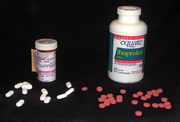
|
|
Treatment for broken ribs and clavicle (click to enlarge) |
Shira picked me up a little more than 24 hours after I departed for my ride. Now, six days after the accident, I'm seeing various signs of improvement. I did, however, end up back in the emergency room on Saturday since Shira didn't like the redness and swelling that started to form around my ankle. The doctor concurred that the ankle was infected, and now I have to take an antibiotic. C'est la vie.
|
|
|
In the past I may have broken a toe, or two, but I never had any real broken bones. Now I have at least eight of them. Hopefully I've fulfilled my quota and that will be the end of it! In any case, if nothing else, I know that I will never, ever ride a bike again without a good helmet strapped to my head. I worked as a bicycle messenger for a year and never once wore a helmet. I certainly dodged a bullet there! Had I not had a helmet on this time, it would have been up to my widow to create this page.
Careful out there!
Postscript: Because I continue to be a klutz, six years after the accident I was lucky enough to get an X-ray of my shoulder. This enabled me to clearly see why there is now a nice bump along the “line” of my collar bone. (Not shown is the torn tendon that got me back under the X-ray machine. Doh! But, a bit of surgery should fix that. Afterall, what are doctors for?)
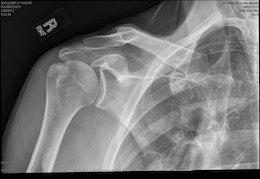
|
|
X-ray of collar bone taken six years after accident (click to enlarge) |